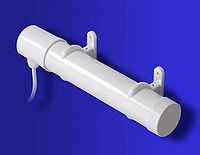Tube Heaters
Tube Heaters, or tubular heaters, are used mainly in custom heating applications. Most Tube Heaters use a sheath or sleeve as a protective outer covering for the heater elements. Tubular heaters differ in terms of features and options. Some products are corrosion resistant, explosion-proof, finned, or portable. Others are suitable for cryogenic use or provide dynamic power regulation. Hazardous location heaters are designed for use in places where there is a risk of fire or explosion. Underwriters Laboratories (UL) and other organizations rate these devices. Indirect fired heaters use a secondary heat exchanger to separate the breathable air stream from the combustion air stream. Features for tubular heaters also include overheat protection, independent timing controls, and internal temperature detectors.
Constructions
Tubular heaters can be formed into virtually any shape, brazed or welded to any metal surface, and cast into metals.
The tubular heater’s basic construction consists of a computer-designed helical coil of 80% Nickel 20% Chromium alloy resistance wire fusion welded to the nickel-coated steel terminal cold pins. This assembly is precisely stretched and centered in the element metal sheath, which is then filled with Grade “A” Magnesium Oxide powder (MgO). The filled tube is then compacted by a roll reduction mill into a solid mass, permanently stabilizing the coil in the center of the tube while providing excellent heat transfer and dielectric strength between the coil and the sheath.
Features
Steel, stainless steel, copper, or Incoloy sheathed elements. Element wire situated in proximity to outside surface for maximum heat transfer and minimum internal temperature while preserving good dielectric qualities. Pure magnesium oxide compressed to an optimum density for best heat transfer and electrical insulation at elevated temperatures.
Video
